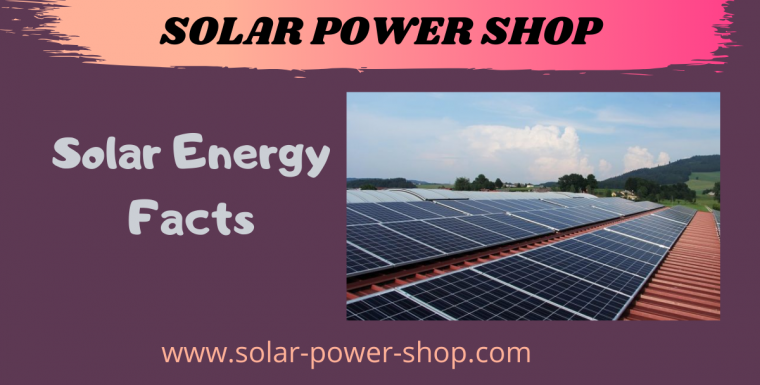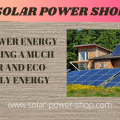This article will address some of the most intriguing solar energy facts. Solar energy is generally one of the most ecologically sound and desirable sources of power these days.
Let’s get going with the obvious. Solar power has been in existence since the dawn of time. It has been used by microbial, plant, and animal life as a primary energy supply. Plants, using photosynthesis, create nearly all of the food on the earth and are at the base of the food chain. Furthermore the fossil fuels we rely on so heavily nowadays are created from plants and animals that lived a long time ago. Only in recent times have human beings been able to capture solar energy so that it may be utilized any time of day and night, and in any weather, stored and transferred.
Annually, the earth’s atmosphere absorbs 3.85 million exajoules of energy from our sun. This most likely doesn’t mean much to you, however by comparison, the entire use of electric energy by all people today around the world is just 56.7 exajoules per year. This indicates that within a few hours, the earth receives more energy from the sun than people expend during an entire year! Solar energy is a remarkably clean supply of energy simply because, in contrast to fossil fuels, making use of this kind of energy doesn’t discharge carbon dioxide or other types of harmful toxins into the environment. Furthermore solar energy is collected by almost every single form of life. You’ve almost certainly never seen a reptile collect wood to start a fire, but you most likely have seen one lying on a rock to absorb solar energy. Solar power is probably the most environmentally sound energy option attainable right now.
Perhaps you may be wondering what exactly solar power is capable of doing for our environment. Every year, humans consume 467 exajoules of energy by utilizing several principal power sources: burning coal, gasoline, and oil, along with ‘green’ sources like wind, solar, and hydro energy. However, if we could capture just 10% of the sun’s energy, we would have the capacity to replace all of the fossil fuel sources and have enough space for growth. Without any doubt solar energy facts like this make it clear how much better solar power is for the environment and how great the potential is for solar energy development.
Considering that you’ve seen some of the most remarkable solar energy facts and now have an understanding regarding what solar energy can possibly do for the environment, you’d probably want to know just exactly what solar energy is. To put it simply, solar energy is the heat and light energy emitted from the sun. The sun constantly generates vast quantities of energy into our solar system. Approximately 30% of the sun’s energy that reaches the earth is immediately deflected by the atmosphere, and another 20% is absorbed into the atmosphere. However, around 50% of the energy actually reaches the earth’s surface, where it fuels photosynthesis in plants, maintains both hot tropical and warm temperate climates, maintains the temperature of the ocean, and generally speaking keeps our planet alive. All of this is accomplished without creating any pollution or destruction of natural resources.
A lot of people don’t understand how solar energy functions on the technical level, and so they wonder just what solar energy is going to provide to their homes, businesses, and communities. In the last three decades, solar energy technology has developed at an accelerated rate. Solar energy is gathered at a number of large power plants in the U.S., Spain, Australia, and in other nations, where it delivers power directly to the power grid. This implies that countless houses around the globe already get electrical power generated by the sun. One of several lesser known solar energy facts is that solar power can also be employed on a considerably smaller scale. Solar panels on households and businesses, can certainly create a percentage (or possibly all) of the power these buildings have to have. On an even smaller scale, solar panel systems are put to use in India and Indonesia to disinfect water, and compact solar burners and ovens are often employed in order to cook food in other regions of the globe. Solar energy might be employed to power practically any procedure you can visualize, from large-scale power generation for towns and cities to boiling a single pot of water.
What makes all of these different uses achievable is the development of solar energy systems. You will notice two standard varieties of solar energy technologies presently used today: solar thermal energy (STE) and photovoltaic (PV) energy. Solar thermal collectors just harness the heat or thermal energy generated by the sun. This thermal energy is generally used to heat water which in turn can easily be stored and used for common every day requirements or piped to a household heating system. STE may be stored by heating up or energizing a thermal mass that is designed to continue to radiate heat even when the sun isn’t shining. Solar thermal collectors actually are significantly more efficient in comparison with photovoltaic collectors but on the other hand energy storage is somewhat more cumbersome. Photovoltaic solar panel systems produce electricity when exposed to sunlight. This electric current may be used immediately or alternatively stored by using batteries for later use. This is actually one of the more significant solar energy facts whenever you are dealing with PV energy systems. Battery storage is incredibly significant since it means it is possible to store solar power for use through the night or during cloudy or rainy days.
Solar energy is a very important alternative power source which can help us take care of our environment. It can also help to cut down our reliance on fossil fuels. You may be asking yourself just how big of an expense it is going to be for you to convert to solar power? Solar power is not really as costly as most people think. A total solar energy system for a house can potentially cost more than $30,000, having said that this does not really mean you will be paying that total amount. To begin with, you will discover lots of different incentive plans, which include tax credits, rebates and grants, that may reduce the price of installing solar panel systems by 30% or more. One other option you might wish to look into is a smaller solar energy system that just supplements your household power needs. A smaller sized system will cost considerably less, while still lowering your current energy bills, and it will certainly help make your home much more environmentally sound. Currently most electrical power is generated using fossil fuels. So lowering your use of electrical power from the area power company by 50% is actually an important step towards establishing a sustainable power grid.
In this article, we’ve made an effort to supply you with a number of helpful and thought provoking solar energy facts. While you contemplate these facts, also think about just how much value you put on the quality of the environment and on humanity’s ability to preserve it. No matter if fossil fuels do not run out during the next 50 years, it’s very likely that their continued use as our primary energy source is going to wreak environmental havoc. Investing in solar power now might not instantly help you save money, but your monetary investment can certainly provide an improved future for everybody under the sun.
Article Source: Solar Energy Facts







